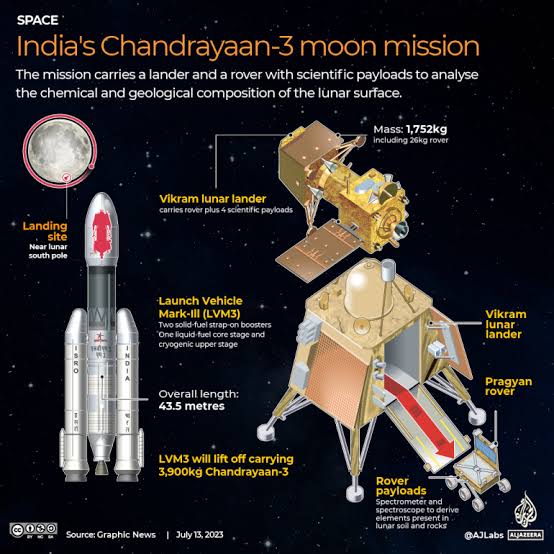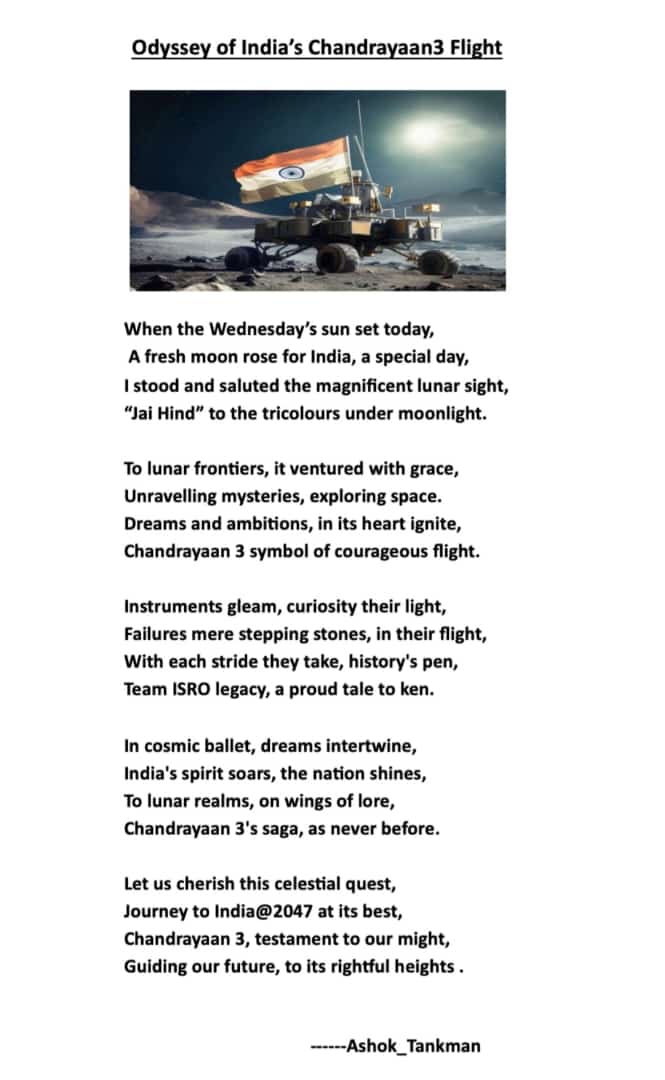“Congratulations ISRO …. India is Proud of You”
Those who dare to dream big with their eyes open only they can make their dreams come true. Failures only reinforce the will to win which knows no bounds. Even success is a never-ending journey, paving the path for many a glorious endeavour for the future. This is the story of India. This is the story of mankind. This is the story of ISRO’s Chandrayaan – 3 Lunar Mission which landed on the lunar south pole on August 23, 2023. A pioneering endeavour in space research and a most significant achievement for mankind.
Mystic Mysteries of the Moon
In the vast expanse of the cosmos, the Moon has remained a celestial muse for explorers, scientists, and dreamers alike. Over the years, the Moon has beckoned humanity with its mysteries and secrets, prompting nations to embark on daring missions to unveil its enigmatic past and potential. India, with its remarkable strides in space exploration, has carved its path in this cosmic quest with its Chandrayaan series. Chandrayaan-3, the third mission in this series, has taken India’s lunar exploration to new heights, cementing its place among the global spacefaring community and reaffirming its commitment to scientific advancement and international collaboration.
A Legacy of Lunar Pursuits
The Chandrayaan series, a saga of India’s lunar pursuits, serves as a testament to the nation’s growing capabilities in space technology. It began with Chandrayaan-1, launched in 2008, which made headlines by confirming the presence of water molecules on the lunar surface and providing crucial insights into the Moon’s mineral composition.
Chandrayaan-2, launched in 2019, aimed for a more ambitious goal: a soft landing near the Moon’s south pole. While the orbiteer of Chandrayaan-2 continued to operate successfully and send data back to Earth, the lander faced challenges during its descent, resulting in a loss of communication. With the lessons learned from Chandrayaan-2, the Indian Space Research Organisation (ISRO) in the warrior spirit of “Never Say Die”, set its sights on Chandrayaan-3, determined to achieve the elusive goal of a soft landing on the lunar surface and further enhance India’s prowess in space exploration.
Unlocking Lunar Secrets: Focus on the South Pole
In the captivating realm of space exploration, India’s Chandrayaan-3 mission has created history by landing on the lunar South Pole – a region of exceptional intrigue and untapped potential.
With a relentless pursuit of unearthing water on the Moon, this mission’s objectives are geared towards uncovering secrets hidden within the enigmatic craters of the lunar southern region. As revelations from past missions and remote sensing unveil, the lunar South Pole harbours an assortment of permanently shadowed craters. These craters, shrouded in perpetual darkness, are emerging as the most likely depositories of water on the lunar surface.
This prospect has propelled both ISRO’s Chandrayaan-3 and NASA’s Artemis III missions to target this polar treasure trove, driven by the promise of unlocking cosmic mysteries and scientific revelations. India has become the first country to softly land a spacecraft on the lunar South Pole. This landmark achievement will not only solidify India’s stature in space exploration but will also elevate the country to the ranks of the United States, the Soviet Union, and China – the only nations that have successfully achieved soft landings on the Moon. Indeed 21st century is the Indian Century.
Exploring New Frontiers: Chandrayaan-3’s Objectives
At the heart of Chandrayaan-3’s mission is the quest for knowledge about the Moon’s past, its present, and its potential role in humanity’s future. The mission’s primary objective is to successfully place a lander and a rover on the Moon’s highlands near its south pole. This remarkable achievement isn’t just about planting a flag on lunar soil; it’s about demonstrating India’s capability to engineer and execute a precision landing on a celestial body millions of kilometres away.
Chandrayaan-3’s ambitions go beyond landing. The mission aims to conduct a series of in-situ scientific experiments that will offer insights into the Moon’s mineral composition, surface temperature, seismic activity and more. By analysing these data, scientists hope to piece together the Moon’s history, from its formation to its subsequent evolution.
Furthermore, Chandrayaan-3 serves as a technological proving ground. The mission’s success will validate key technologies required for future interplanetary missions. From communication systems to propulsion mechanisms, the challenges overcome in Chandrayaan-3 will pave the way for even more daring explorations of the cosmos.

The Lander and Rover Duo: Vikram and Pragyan
At the heart of Chandrayaan-3’s mission are the intricate manoeuvres between two remarkable machines: the lander and the rover, named Vikram and Pragyan respectively, these vehicles are the embodiment of India’s scientific and engineering prowess. Their journey will take them to the Moon’s uncharted territories, offering humanity a close-up look at regions that have remained hidden from view for ages.
The Vikram lander was designed to perform a soft landing on the lunar surface. This delicate manoeuvre required a combination of propulsion control, trajectory calculations, and real-time adjustments. The successful execution of this manoeuvre marked a historic achievement for India and added a new chapter to the story of lunar exploration.
Once safely on the Moon, the Pragyan rover will spring into action. Equipped with a suite of advanced instruments, Pragyan is poised to traverse the lunar landscape, collecting data and capturing images that will shed light on the Moon’s geological features, mineral composition and more. The rover’s journey promises to be a remarkable scientific endeavour, uncovering clues about the Moon’s past and its relevance to understanding Earth’s history.
The Payload: Instruments of Discovery
Chandrayaan-3’s lander module carries a payload of instruments that are poised to revolutionise our understanding of the Moon. Among these instruments is Chandra’s Surface Thermo-physical Experiment (ChaSTE), which will study the Moon’s thermal properties and provide insights into its surface temperature variations.
The Instrument for Lunar Seismic Activity (ILSA) is another crucial instrument aboard the lander. It will help detect and analyse seismic activity on the Moon, providing valuable data about the Moon’s interior configuration and its geological processes.
The Laser Retro-reflector Array (LRA) Rover is designed to enhance the precision of measurements taken from Earth-based observatories. By reflecting laser beams to their point of origin, the LRA will facilitate accurate distance measurements, helping scientists refine their understanding of the Moon’s orbit and its relationship with Earth.
Perhaps one of the most intriguing instruments is the Radio Anatomy of Moon Bound Hypersensitive Ionosphere and Atmosphere (RAMBHA). This instrument aims to study the ionosphere and exosphere of the Moon, offering insights into its atmospheric composition and interaction with solar radiation.
As Chandrayaan-3 landed on the moon, the excitement in the global scientific community was palpable. The mission isn’t just a testament to India’s scientific and technological prowess; it’s a milestone in the on-going human endeavour to explore the cosmos and unlock its mysteries. Chandrayaan-3’s journey is a saga for space enthusiasts, scientists, and dreamers alike. As the lander module, Vikram and Pragyan, descended gently onto the Moon’s surface, it marked a historic moment, not only for India but also for all of humanity.

Chandrayaan-3 stands as a testament to India’s unwavering commitment to space exploration, scientific discovery and global collaboration. By setting its sights on the lunar South Pole, the mission will unveil the Moon’s secrets, inching us closer to understanding our place in the cosmos. As the world held its breath, Chandrayaan-3 embarked on a journey that will leave an indelible mark on our understanding of the Moon and our aspirations for exploring the universe beyond. India leads and the World wins. Indeed India is the Vishwa Guru in the 21st Century.
-The writer is a defence veteran, a recipient of PVSM, AVSM, and VSM. The views expressed are of the writer and do not necessarily reflect the views of Raksha Anirveda






